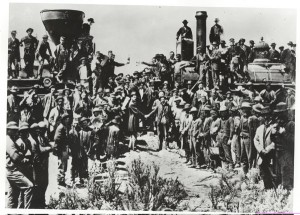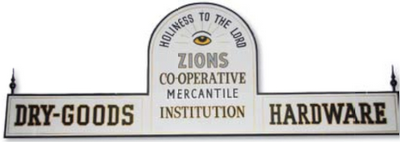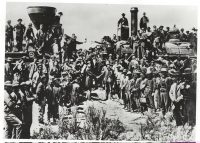Building on the great strides taken by the LDS Church in their 2nd decade in Utah to achieve independence from the American economic system, the Saints during their 3rd decade went to even greater lengths to insulate themselves from “Babylon” .
 In 1867, Church leaders realized the soon-to-be-completed railroad would threaten the social and economic unity they had achieved to date. So, Brigham Young organized the territory’s leading High Priests into what functioned essentially an economic planning commission in every Stake. Curiously, he named it, “The School of the Prophets” and its membership roles peaked at around 5,000. These local and territorial councils were tasked with identifying and implementing programs to preserve the relative economic equality, unity, and self-sufficiency the Saints had achieved during their first two decades of Zion-building in the mountain west.
In 1867, Church leaders realized the soon-to-be-completed railroad would threaten the social and economic unity they had achieved to date. So, Brigham Young organized the territory’s leading High Priests into what functioned essentially an economic planning commission in every Stake. Curiously, he named it, “The School of the Prophets” and its membership roles peaked at around 5,000. These local and territorial councils were tasked with identifying and implementing programs to preserve the relative economic equality, unity, and self-sufficiency the Saints had achieved during their first two decades of Zion-building in the mountain west.
According to church historian Leonard J. Arrington in his monumental work, “Great Basin Kingdom”, the School of the Prophets [SotP], with the assistance of the Women’s Relief Society, “countered an energetic and financially powerful laissez-faire capitalism with a vigorous, well-organized, socially minded, and theocratically directed program of economic action”. In other words, Zion was about to be swallowed up by Babylon, so they knew they had to act quickly to organize the Saints even further in Zion-like fashion.
 The School of the Prophets implemented various projects to help the Saints take collective advantage of the coming railroad by encouraging home production of goods and organizing the Saints in ways to assist the ease of their exporting these goods to the benefit of all. They established community-owned producer cooperatives to eliminate unemployment and decrease dependency on imports of consumer goods from the East. They built North-South running rail lines to facilitate exporting the Saints’ manufactured goods. And, they created a central Zion’s Cooperative Mercantile Institute (ZCMI) in Salt Lake and in 100 settlements to handle ALL imports to the Territory to prevent price gouging.
The School of the Prophets implemented various projects to help the Saints take collective advantage of the coming railroad by encouraging home production of goods and organizing the Saints in ways to assist the ease of their exporting these goods to the benefit of all. They established community-owned producer cooperatives to eliminate unemployment and decrease dependency on imports of consumer goods from the East. They built North-South running rail lines to facilitate exporting the Saints’ manufactured goods. And, they created a central Zion’s Cooperative Mercantile Institute (ZCMI) in Salt Lake and in 100 settlements to handle ALL imports to the Territory to prevent price gouging.
 Some of the more important cooperative enterprises launched included the Utah Manufacturing Company which produced wagons and farm equipment; the Provo Woolen Mills, and various factories to produce furniture, buckets, ink, and matches.
Some of the more important cooperative enterprises launched included the Utah Manufacturing Company which produced wagons and farm equipment; the Provo Woolen Mills, and various factories to produce furniture, buckets, ink, and matches.
The Saints knew they couldn’t stop the railroad from coming, so they did the next best thing, they organized themselves cooperatively so it’s coming would benefit all instead of a few.
Your thoughts?
